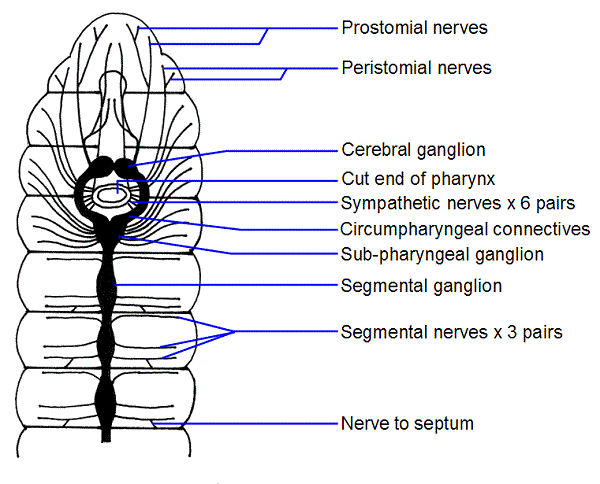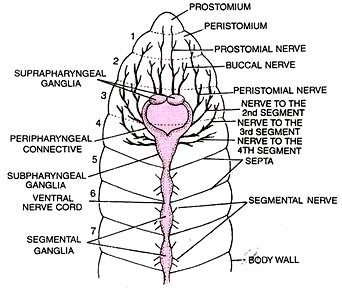Does an Earthworm have a brain? Do Earthworms have a head?
Does an Earthworm have a brain?
Yes, an earthworm does have a brain. It’s not like a well-developed brain like that of humans.
The brain of an earthworm is like a nerve ring which is a part of the central nervous system located in the anterior end of the body inside its so-called head region.
The central nervous system (CNS) controls most functions of the body of the earthworm and remains connected and controls the other nerves of the body.
The brain is a bilobed-structure that comprises of two cerebral ganglia or supra-pharyngeal ganglia in the anterior nerve ring region of the earthworm’s head.
It is to be noted that cerebral ganglia are also called supra-pharyngeal ganglia because, from either side of the supra-pharyngeal ganglia, a pair of thick short band circum-pharyngeal connective nerves arise which enclose the pharynx.
The brain is really very simple because Earthworms have a simple nervous system.
The cerebral ganglion is connected to the ventral nerve cord that runs along the length of the body of the earthworm.
Each body segment of the worm is connected to the cord of the cerebral ganglion, allowing earthworms to move and respond to light, touch, chemicals, vibrations, and more.
It is also to be noted that, the supra-pharyngeal ganglia (brain), sub-pharyngeal ganglia, and the circum-pharyngeal connective nerves form a nerve ring around the pharynx.


About the Brain or Cerebral Ganglion of Earthworm
The brain of the earthworm is also known as the cerebral ganglion or supra-pharyngeal ganglia.
The nervous system of the earthworm is well-developed, concentrated, and really very simple. It consists of 3 parts: Central, Peripheral, and Sympathetic Nervous System.
The brain is part of the nerve ring of the central nervous system (CNS). The CNA comprises of a pair of cerebral ganglia (brain), along with circum-pharyngeal connective nerves, and the sub-pharyngeal ganglia.
The brain is relatively simple in structure and is a bilobed mass lying above the pharynx that is in the depression between the buccal cavity and pharynx in the 3rd body segment.
The segments of the body are called metameres and there are altogether 100 to 120 similar metameres in the body from anterior to the posterior end.
The cerebral ganglion is the main central processing and thinking unit of the earthworm as it is the only brain that is well-connected to all parts of the body.
This brain or the cerebral ganglion is connected to a ventral nerve cord that runs along the length of the body.
Each segment (metamere) is well-connected to this ventral nerve cord coming out of the brain, allowing earthworms to move and respond to light, touch, chemicals, vibrations, and more.
The brain is also the main nerve of the body that allows it to know when to reproduce, breed, and recognize its mates for the purpose.
Do Earthworms have a head?
No, earthworms don’t have a distinct head and sense organs like eyes, ciri, and tentacles. In other words, the anterior end of the earthworm do look like a head but it is not a true head.
It looks like a head because the first segment of the anterior end of the body is called buccal segment or peristomium bearing the mouth.
Moreover, the portion above the clitellum is what sometimes referred to as the head, but that is not the true head as already said.
This portion above the clitellum is called the head because it contains all the cerebral nerves, the brain, circum-pharyngeal connective nerves, the sub-pharyngeal ganglia, the upper portion of the ventral nerve cord, and many segmental nerves.
Some people often get confused thinking that Earthworms may have two heads as it can move both forward and backward.
But, in reality, the earthworm does have only one head (so-called false head) and not two heads as it can move both in forward as well as backward direction.
The head portion of the earthworm is always located at the anterior end closest to the clitellum.
And, it has also been seen that the earthworm will usually extend their head first when crawling and that’s the general body mechanism.
Another reason to support the presence of only a single head in the anterior part of the earthworm is the way it can regenerate itself after being cut in half.
If you cut the earthworm behind the clitellum than only it can survive, or else if you cut above the clitellum than the chances are very very high that it will die.
Now there are two scenerios that can happen if you cut the earthworm at any of its segment behind the clitellum.
In the first scenario, the cut head part of the earthworm that has the clitellum will survive as the earthworm can regenerate the rest of the part of the tail and mid-body because its brain is there to process the information.
At the second scenario, the cut part of the tail that is without the clitellum will not survive as the earthworm can’t regenerate the rest of the head and clitellum.
Do earthworms have any sense organs?
Earthworms don’t have the sense organs like eyes, cirri, and tentacles, but they do have other well-developed sense organs like epidermal receptors, buccal receptors, and photo-receptors.
These sense organs are actually very complex functioning and are quite simple in their structure consisting of a single cell or a group of many specialized cells.
The Epidermal receptors cells are located on all over the outer surface of the earthworm’s skin mostly on the lateral sides and ventral surface of the body.
These epidermal receptors have very simple hair like projections coming out of the skin surface and are very much sensible to touch and can respond to chemical stimuli and also to the changes in temperature.
The Buccal receptors cells are located on the outer skin surface of only the buccal chamber in the mouth of the earthworm at the anterior end.
These buccal receptors also have many better developed sensory hair like projections that can feel the taste and smell and can also respond to the other chemical stimuli through its mouth.
The Photo-receptors cells are located only on the dorsal surface of the earthworm, and these are totally absent in the clitellum. These cells also gradually decrease in number from the anterior towards the posterior end of the body.
Photo-receptors cells enable earthworms to judge the intensity and duration of light. So, these are very important as these will signal the worm to be away from the sunlight or else it can die due to the high intensity of light.
Central Nervous System Vs. Peripheral Nervous System Vs. Sympathetic Nervous System of Earthworm
➜ Central Nervous System
The central nervous system consists of the anterior nerve ring and the ventral nerve cord connected to the nerve ring.
The nerve ring comprises of a pair of cerebral ganglia (brain), circum-pharyngeal connective nerves, and the sub-pharyngeal ganglia.
The ventral nerve cord comprises of a left and right cord arising from the sub-pharyngeal ganglia of the nerve ring and runs to the posterior end of the body.
From the ventral nerve cord, arises various segmental nerves that connect to every part of the body.
The nerve ring consists of those nerves that function as the central information processing and thinking unit of the body.
The ventral neve cord acts as like the spinal cord of higher animals and is the main nerve that helps to transport all of the information from the nerve ring to the other parts of the body.
➜ Peripheral Nervous System
The peripheral nervous system includes those peripheral nerves of the earthworm arising from the lateral regions of the cerebral ganglion, sub-pharyngeal ganglion, circum-pharyngeal connective nerves, and from the ventral cord and passing throughout the body.
8 to 10 pairs of nerves arise from the brain which communicates or innervates or supply to prostomium, buccal cavity, and pharynx.
2 pairs of nerves arise from cirum-pharyngeal connectives which supply to the wall of the prostomium and peristomium segment.
3 pairs of nerves arise from sub-pharyngeal ganglia which supply to the 2nd, 3rd and 4th segment.
And, 3 pairs of nerves arise from each segmental ganglion which supplies to the various parts of the segment, gut wall, body wall, and other internal organs.
➜ Sympathetic Nervous System
The Sympathetic Nervous System consists of an extensive nerve plexus (a network of intersecting nerves) spread beneath the skin surface, within the muscles of the body
This nerve system also forms various sensory and motor nerve that fuses to form nerve plexuses that also move ventrally through the alimentary canal.
These plexuses are connected with the circum-pharyngeal connective nerves.
